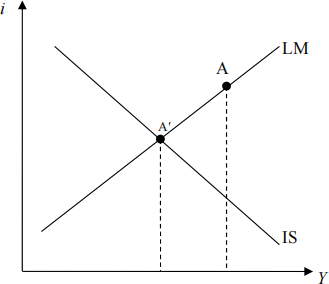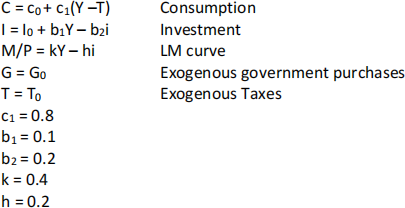ECON5002: SAMPLE EXAM 1
Hello, dear friend, you can consult us at any time if you have any questions, add WeChat: daixieit
ECON5002: SAMPLE EXAM 1
This section is compulsory and contains 20 multiple‐choice questions. Suggested time allotment: 60 minutes for the section. All questions are equally weighted.

1. In the IS‐LM diagram above, if an economy is at point A we know that
a. the money market and the goods market are in equilibrium
e. none of the above
2. Which type of policy can have a medium‐run effect on output and employment?
a. labour market policy
b. monetary policy
c. fiscal policy
d. both (a) and (b)
e. all of the above.
3. In the IS‐LM model we can expect the IS‐curve to become steeper as
a. the marginal propensity to consume increases
c. investment becomes less sensitive to interest rate changes
e. all of the above
4. In the income‐expenditure model an increase in the marginal propensity to consume from 0.42 to 0.78 will cause:
a. the ZZ line (representing the aggregate demand function) to become flatter and a given change in autonomous consumption (c0) to have a smaller effect on output
b. the ZZ line to become steeper and a given change in autonomous consumption (c0) to have a larger effect on output
c. the ZZ line to become flatter and a given change in autonomous consumption (c0) to have a larger effect on output
d. the ZZ line to become steeper and a given change in autonomous consumption (c0) to have no effect on output
5. Consider the IS‐LM framework. If the central bank decreases the price target and government spending increases, then we know that in the short run:
a. output rises; interest rate decreases
c. output rises; effect on interest rates is ambiguous
d. interest rate rises; output decreases
6. Consider the AS‐AD framework. A permanent decrease in government spending will in the medium run lead to
a. no effect on output
c. higher investment
e. all of the above
7. The aggregate demand curve will shift to the right when which of the following occurs?
a. a reduction in the markup ratio
c. a rise in the price level
e. none of the above.
8. Suppose we wish to examine the determinants of the equilibrium real wage and the equilibrium level of employment. In a graph with the real wage on the vertical axis, and the level of employment on the horizontal axis, the wage‐setting relation will now be:
a. a vertical line.
c. a horizontal line.
9. An increase in government spending will, in the medium run, cause no change in:
a. unemployment and price level
c. the price level and the interest rate
e. none of the above.
10. In the medium run, a decrease in the budget deficit will
a. increase output
c. decrease the interest rate
11. In the AS‐AD model if the central bank targets the price level, a permanent increase in government spending will cause which of the two following effects in the medium run:
(I) the price level will increase
(II) the interest rate will increase
a. I is true, II is not
c. both I and II are true
12. Suppose firms in the Australian economy have market power and, therefore, set prices P equal to the wage rate W plus a mark‐up m on W (i.e. P = (1 + m)W). Then an increase in the mark up m, assuming everything else remaining constant, will cause in the medium run:
a. the RBA will raise the interest rate
c. investment will increase
13. If discouraged job seekers re‐enter the labour force but do not find work, they will:
a. increase the measured unemployment rate
14. Consider the AS‐AD framework. In the short run, a reduction in the price of oil will cause:
a. a reduction in output
c. a reduction in the interest rate
e. none of the above.
15. Which of the following would cause the natural rate of unemployment to increase?
a. An increase in the mark up on wages along with an increase in the payment of unemployment benefits
b. A decline in the mark up on wages by 10% along with no change in the payment of unemployment benefits
c. A decline in the mark up on wages by 10% along with a decline in the payment of unemployment benefits by 10%
d. none of the above
16. If u < un, we know with certainty that:
a. P > Pe
b. P < Pe
c. P = Pe
e. none of the above.
17. Suppose the economy is described by the following behavioural equations:
Equilibrium GDP is ‐‐‐ and equilibrium consumption is ‐‐‐, and an increase in T by 10 would cause equilibrium income to decrease by ‐‐‐
a. 1000; 540; 25
b. 1000; 700; 25
c. 1150; 540; 15
d. 1150; 700; 15
e. 1000; 700; 15
18. In the AS‐AD model the aggregate supply curve will shift leftward (upward) when
a. there is an increase in unemployment benefits
c. the central banks adopts a restrictive monetary policy
e. none of the above
19. A decrease in the real money supply caused by an increase in the price level is graphically represented by
a. a movement along the AD curve to the right
c. a movement along the AD curve to the left
e. a shift of the AD curve to the right.

Increase in government spending by $1 will increase the short‐run equilibrium output by ‐‐‐‐‐, and will shift the IS curve horizontally by ‐‐‐‐‐‐,
a. $2; $2
b. $10; $10
c. $5; $10
d. $2; $10
e. $5; $5
PART B: Analytical Question
This section is compulsory and is worth 10 marks. Suggested time: 30 minutes.
Monetary policy and the interest‐sensitivities ofmoney and investment demand. Consider an IS‐LM model with consumption and investment functions
C = 4 + 0.25(Y‐T); and I = 6 + 0.25Y‐ 10i
and suppose G = 1 and T = 2. Let the real money supply be M/P = 38 and let the money demand function be
(a) Solve for the equilibrium level of output Y and interest rates i. (3 marks)
(b) Consider an expansionary monetary policy that increases the real money supply from M/P = 38 to M/P = 40. Calculate the new levels of output and interest rates. Suppose instead there was zero interest‐sensitivity of investment demand, would monetary policy be more or less effective at stimulating output? Explain. (2 marks)
(c) Suppose instead the interest‐sensitivity of money demand was 50 instead of 40. Calculate the equilibrium levels of output and interest rates for M/P = 38 and M/P = 40. Is the effectiveness of the monetary expansion larger or smaller than in part (b)? Give intuition for your answer. (4 marks)
(d) Now suppose there is an exogenous shock that shifts money demand out to
M/P = 2.4Y‐ 40i
Suppose the central bank wants to achieve the level of output and interest rates from part (a). Calculate the level of the real money supply M/P that will allow the central bank to achieve this outcome. Give intuition for your answer. (1 mark)
2022-02-04